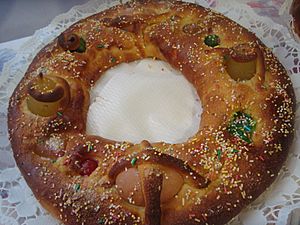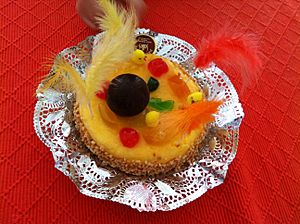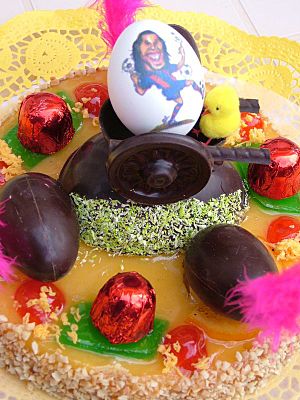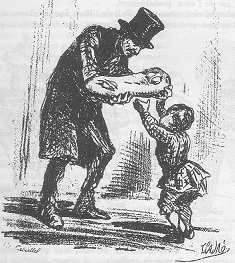Easter mona facts for kids
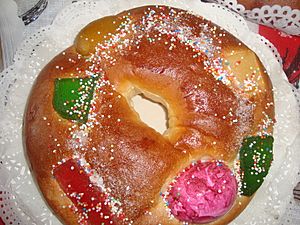
The Easter mona (called Mona de Pascua in Spanish and Mona de Pasqua in Catalan) is a special cake from Spain. People usually eat it on Easter Sunday or Easter Monday. It's very popular in the Spanish regions of Catalonia, Valencia, and Murcia. In other parts of Spain, similar Easter cakes are also enjoyed, though they might have different names or recipes.
Contents
What is the Easter Mona?
The Easter mona is more than just a cake; it's a symbol of spring and a fun tradition. It's often given as a gift and shared with family and friends. Over time, the mona has changed quite a bit. It used to be a simple cake with hard-boiled eggs on top. Now, especially in Catalonia, it's often a fancy chocolate creation!
Where Did the Mona Come From?
Historians believe the idea of the mona is very old. Some writings mention the mona as far back as the 1400s. The word "mona" itself might have a few different origins:
- Muna: This comes from an old Arabic word meaning "gift" or "provision." It was like a tax paid with cakes or eggs.
- Munda: This Latin word referred to special banners with candy that Romans offered in April.
- Munichia: This was a festival in ancient Greece dedicated to the goddess Artemis.
Many people think the tradition started with ancient feasts. Roman shepherds celebrated with cakes, and the Celts had a festival called Beltane in May. During Beltane, they also ate pastries with eggs. These old customs might have led to the Easter mona we know today.
How It's Made and Different Kinds
In the past, the mona was usually round, like a ring-shaped bread. It was a sweet cake, often with hard-boiled eggs baked right into it or placed on top.
Traditional vs. Modern Monas
- Catalonia: Over time, the eggs in Catalonia were replaced by chocolate. Now, the chocolate part is often the main focus of the mona. Bakers create amazing chocolate sculptures and figures.
- Valencia and Murcia: In these regions, the traditional recipe is still very popular. The mona is usually a pastry with a hard-boiled egg on top. Sometimes, it has a sweet, sticky caramel made from egg whites instead of a plain egg.
Other Names for Mona
In Valencia, you can find cakes similar to the mona all year round, even without the hard-boiled egg. They might be called by different names like tonya, panou, pa socarrat, or coca bova.
The Mona Tradition
In Catalonia and Valencia, there's a special custom: godparents give an Easter mona to their godchildren on Easter Sunday. This is a very important part of the Easter celebration.
On Easter Monday, families or groups of friends often gather together. They might go to the countryside or a park to share and eat the mona. It's a fun outing that brings everyone together.
Eggs and Age
Traditionally, the number of eggs on a mona would match the child's age, up until they turned 12. So, a 7-year-old would get a mona with 7 eggs! Nowadays, godparents often continue giving monas to their godchildren even after they are grown up.
Bakers as Artists
Bakers play a huge role in the Easter mona tradition. They have turned making monas into an art form. Since the mid-1800s, monas have become much more elaborate. They are decorated with:
- Caramelized sugar
- Sugar almonds
- Jams
- Crunchy toppings
- Silver sprinkles
- And, of course, chocolate eggs or figures made from porcelain, wood, cardboard, or fabric.
These creations are truly beautiful and a highlight of the Easter celebrations!
See also
 In Spanish: Mona de Pascua para niños
In Spanish: Mona de Pascua para niños


